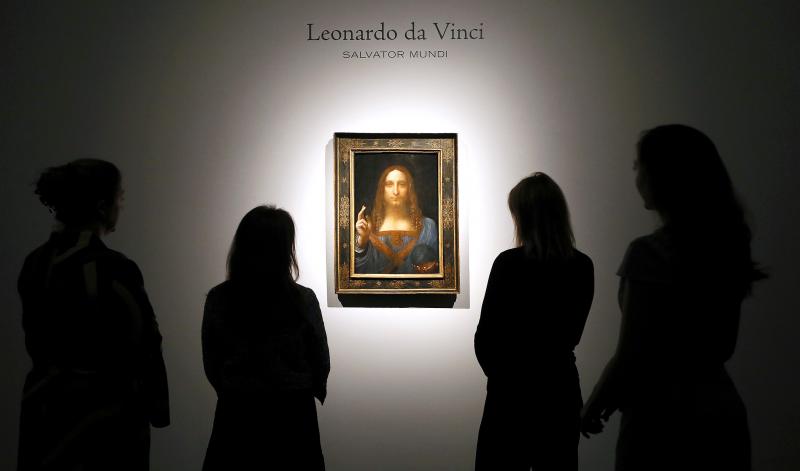A French documentary has cast fresh doubts over the world’s most expensive painting, the Salvator Mundi credited to Leonardo da Vinci, revealing a resulting diplomatic tussle between France and its Saudi owner.
The painting of Jesus Christ, nicknamed the “male Mona Lisa,” was sold at a 2017 Christies auction in New York for a record US$450 million.
Its secret buyer was later revealed to be Saudi crown prince Mohammed bin Salman, though this is still denied in Riyadh. But there have long been questions over whether it was entirely the work of da Vinci.

Photo: AP
The issue resurfaced when the painting failed to appear as planned at the Louvre Abu Dhabi museum in 2018, and then at a blockbuster da Vinci show by the Louvre in Paris the following year. Now a documentary, The Savior for Sale by filmmaker Antoine Vitkine, to be premiered on French TV next week, sets out to reveal what was going on behind the scenes.
In the film, senior officials from President Emmanuel Macron’s government, appearing under pseudonyms, confirm that the Louvre’s scientific analysis of the painting concluded that while it was produced in da Vinci’s workshop, the master himself only “contributed” to the painting. This apparently went down badly with the Saudis.
ROW OVER AUTHENTICITY
“Things turned incomprehensible,” says one of the French officials in the film. “The request by “MBS” [bin Salman] was very clear: show the Salvator Mundi next to the Mona Lisa, and present it as 100 percent a da Vinci.”
The Saudis offered various deals, the official says, but his recommendation to the Elysee was that this would amount to “laundering a US$450 million artwork.”
The documentary alleges that some members of the French government, including Foreign Minister Jean-Yves Le Drian, lobbied on behalf of bin Salman’s request. They were concerned about the impact on France’s wide-ranging strategic and economic relationship with Saudi Arabia.
But Macron ultimately decided to reject bin Salman’s request, leaving it to the Louvre to negotiate with the Saudis on how the painting should be presented in their retrospective, said the documentary. No deal was concluded and the museum has refused to comment on the case.
“The Saudis are afraid of this debate on the authenticity,” says Chris Dercon, who heads one of France’s top museum bodies and advises the Saudi government on art, in the documentary. “They are afraid that people will say, both at home and abroad, ‘You spent all this money for something that is not a da Vinci.’”
The painting was initially bought in 2005 for just US$1,175 by a New York art dealer and restored in the US. Several British experts authenticated the painting as a long-lost da Vinci and it was presented as such at London’s National Gallery in 2011 before being sold to a Russian oligarch for US$127.5 million two years later.

May 11 to May 18 The original Taichung Railway Station was long thought to have been completely razed. Opening on May 15, 1905, the one-story wooden structure soon outgrew its purpose and was replaced in 1917 by a grandiose, Western-style station. During construction on the third-generation station in 2017, workers discovered the service pit for the original station’s locomotive depot. A year later, a small wooden building on site was determined by historians to be the first stationmaster’s office, built around 1908. With these findings, the Taichung Railway Station Cultural Park now boasts that it has

Wooden houses wedged between concrete, crumbling brick facades with roofs gaping to the sky, and tiled art deco buildings down narrow alleyways: Taichung Central District’s (中區) aging architecture reveals both the allure and reality of the old downtown. From Indigenous settlement to capital under Qing Dynasty rule through to Japanese colonization, Taichung’s Central District holds a long and layered history. The bygone beauty of its streets once earned it the nickname “Little Kyoto.” Since the late eighties, however, the shifting of economic and government centers westward signaled a gradual decline in the area’s evolving fortunes. With the regeneration of the once

In February of this year the Taipei Times reported on the visit of Lienchiang County Commissioner Wang Chung-ming (王忠銘) of the Chinese Nationalist Party (KMT) and a delegation to a lantern festival in Fuzhou’s Mawei District in Fujian Province. “Today, Mawei and Matsu jointly marked the lantern festival,” Wang was quoted as saying, adding that both sides “being of one people,” is a cause for joy. Wang was passing around a common claim of officials of the People’s Republic of China (PRC) and the PRC’s allies and supporters in Taiwan — KMT and the Taiwan People’s Party — and elsewhere: Taiwan and

Even by the standards of Ukraine’s International Legion, which comprises volunteers from over 55 countries, Han has an unusual backstory. Born in Taichung, he grew up in Costa Rica — then one of Taiwan’s diplomatic allies — where a relative worked for the embassy. After attending an American international high school in San Jose, Costa Rica’s capital, Han — who prefers to use only his given name for OPSEC (operations security) reasons — moved to the US in his teens. He attended Penn State University before returning to Taiwan to work in the semiconductor industry in Kaohsiung, where he